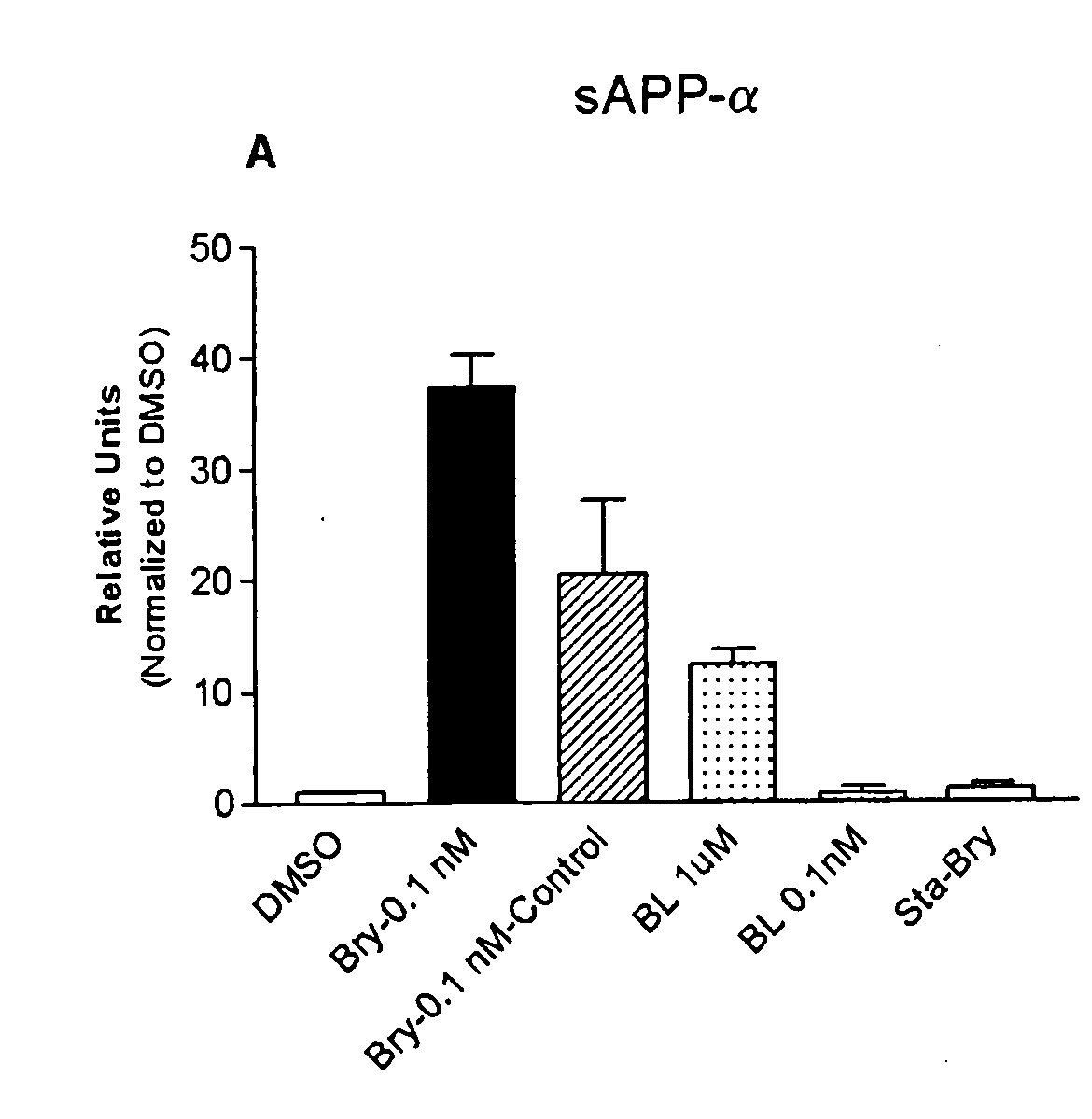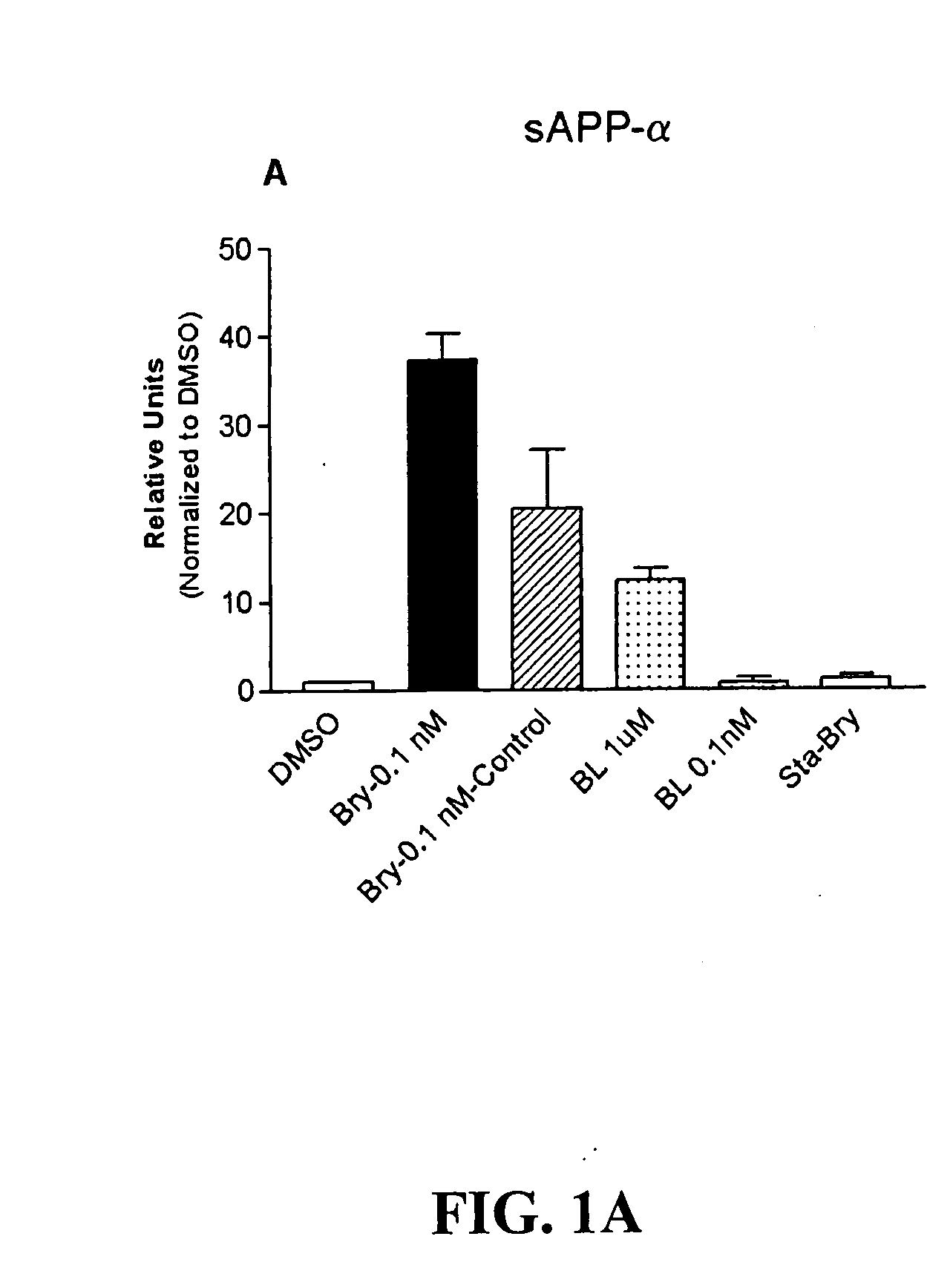PKC activation as a means for enhancing sAPPALPHA secretion and improving cognition using bryostatin type compounds
a bryostatin type compound and activation technology, applied in the field of pkc activation as a means of enhancing sappalpha secretion and improving cognition, can solve the problems of not addressing the progression of the disease, ineffective clinical use and other types of cognition disorders, and improving symptomatic and transient cognition
- Summary
- Abstract
- Description
- Claims
- Application Information
AI Technical Summary
Benefits of technology
Problems solved by technology
Method used
Image
Examples
example i
Cell Culture
[0111]Cultured skin fibroblasts were obtained from the Coriell Cell Repositories and grown using the general guidelines established for their culture with slight modifications (Cristofalo & Carpentier, 1988; Hirashima et al., 1996). The culture medium in which cells were grown was Dulbecco's modified Eagle's medium (GIBCO) supplemented with 10% fetal calf serum (Biofluids, Inc.). Fibroblasts from control cell lines (AC), cases AG07141 and AG06241, and a familial AD (FAD) case (AG06848) were utilized.
PKC Activators
[0112]The different tissue distributions, the apparently distinctive roles of different isozymes, and the differential involvement in pathology make it important to use pharmacological tools that are capable of preferentially targeting specific isozymes (Kozikowski et al., 1997; Hofmann, 1997). Recent research in the medicinal chemistry field has resulted in the development of several PKC activators, for instance different benzolactams and pyrollidinones. Howeve...
example ii
Behavioral Studies
[0119]The Morris Water Maze paradigm (48) was used to study the effects of bryostatin 1 in learning and memory. Wistar albino rats (n=20) weighing between 220-250 g were housed for one week with free access to food and water. Stainless steel cannulas were placed bilaterally in each rat, following previously described procedures (49). All animals had a one-week recovery period prior to any further experimentation. Subsequently, animals were assigned randomly to experimental and control groups. At least 24 h prior to treatment and training, all animals were pre-exposed to the MWM experimental situation by placing them in the water and allowed to swim for 120 s. The training followed standard procedures (49) and consisted of two trials per day for 4 consecutive days. Treated animals received (i.c.v.) 1 μl / site of a 2 μM solution of bryostatin 1 approximately 30 min prior to training trials 1 and 5. The control group received the same volume of vehicle alone, on identi...
example iii
Transgenic Animals and In Vivo Studies
[0122]Transgenic mice carrying the V7171 mutation were treated with BL (1 mg / kg, i.p.; daily) from −3 weeks of age (after weaning) for 17 weeks (n=4). The control group (n=4) received vehicle alone (Tween 20 1%, DMSO 25%, 74% PBS). Another experimental group consisted of 5-6 months old animals treated for 7 weeks. Subgroups of these animals were treated with BL 1 mg / kg, daily (n=5); BL 10 mg / kg, daily (n=3; due to two deaths); BL 10 mg / kg, weekly (n=4; one death), LQ12 10 mg / kg, daily (n=5); and LQ12 10 mg / kg, weekly (n=5). Five additional animals received vehicle alone for the same period. After completion of the treatment, animals were euthanized according to K.U.L. (Belgium) guidelines. Brains were removed and prepared for biochemical analyses of APP species.
Biochemical Analysis of APP Processing in Brain of APP tg Mice
[0123]Immunoblot analysis. The biochemical analysis of intermediates of APP metabolism has been described elsewhere by Dewach...
PUM
| Property | Measurement | Unit |
|---|---|---|
| Molar density | aaaaa | aaaaa |
| Molar density | aaaaa | aaaaa |
| Volume | aaaaa | aaaaa |
Abstract
Description
Claims
Application Information
 Login to View More
Login to View More - R&D
- Intellectual Property
- Life Sciences
- Materials
- Tech Scout
- Unparalleled Data Quality
- Higher Quality Content
- 60% Fewer Hallucinations
Browse by: Latest US Patents, China's latest patents, Technical Efficacy Thesaurus, Application Domain, Technology Topic, Popular Technical Reports.
© 2025 PatSnap. All rights reserved.Legal|Privacy policy|Modern Slavery Act Transparency Statement|Sitemap|About US| Contact US: help@patsnap.com



